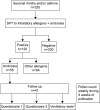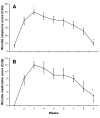Allergic rhinitis and asthma in southern Croatia: impact of sensitization to Ambrosia elatior
- PMID: 17309141
- PMCID: PMC2080503
Allergic rhinitis and asthma in southern Croatia: impact of sensitization to Ambrosia elatior
Abstract
Aim: To identify pollen types in southern Croatia and investigate the impact of sensitization to Ambrosia elatior (A. elatior) on symptoms and treatment of patients with seasonal allergic rhinitis and/or asthma.
Methods: The study recruited 120 patients from Split-Dalmatian County with seasonal rhinitis and asthma symptoms and positive skin prick test to one or more common inhaled allergens. Patients with positive skin prick test and increased specific IgE to A. elatior (n=56) were included in the follow-up study during the A. elatior pollen season. Rhinitis and asthma symptoms were scored and drug treatment recorded using standardized questionnaires. Also, forced vital capacity (FVC), forced expiratory volume in one second (FEV1), peak expiratory flow (PEF), and eosinophil count in peripheral blood were measured. Type and pollen concentration of A. elatior in the air over the nine-week pollen season were determined on the glass slides using the gravimetric method. The results were expressed as the proportion of A. elatior pollen in the total pollen.
Results: Fifty-six of 120 patients (46.7%) were sensitized to A. elatior. Its proportion in total pollen peaked to 12% in the first week of September. Forty-one patients who completed the follow-up study showed a significantly higher score of symptoms during this peak period than in the beginning of the pollen season for seasonal allergic rhinitis (median +/-interquartile range, 50+/-11 vs 7+/-4; P<.001) and for seasonal allergic asthma (12+/-2 vs 0+/-0; P<.001).
Conclusion: A. elatior is an important cause of seasonal allergic rhinitis and asthma and must be included in the routine diagnostic procedures in southern Croatia.
Figures





Similar articles
-
Incidence of Betulaceae pollen and pollinosis in Zagreb, Croatia, 2002-2005.Ann Agric Environ Med. 2007;14(1):87-91. Ann Agric Environ Med. 2007. PMID: 17655183
-
Seasonal changes of proapoptotic soluble Fas ligand level in allergic rhinitis combined with asthma.Pediatr Allergy Immunol. 2006 Sep;17(6):444-9. doi: 10.1111/j.1399-3038.2006.00415.x. Pediatr Allergy Immunol. 2006. PMID: 16925690
-
Efficacy and safety of subcutaneous immunotherapy with a biologically standardized extract of Ambrosia artemisiifolia pollen: a double-blind, placebo-controlled study.Clin Exp Allergy. 2004 Sep;34(9):1408-14. doi: 10.1111/j.1365-2222.2004.02056.x. Clin Exp Allergy. 2004. PMID: 15347374 Clinical Trial.
-
[Ambrosia pollinosis].Rev Mal Respir. 2013 Apr;30(4):316-27. doi: 10.1016/j.rmr.2012.10.632. Epub 2013 Feb 1. Rev Mal Respir. 2013. PMID: 23664290 Review. French.
-
Role of pollen NAD(P)H oxidase in allergic inflammation.Curr Opin Allergy Clin Immunol. 2008 Feb;8(1):57-62. doi: 10.1097/ACI.0b013e3282f3b5dc. Curr Opin Allergy Clin Immunol. 2008. PMID: 18188019 Free PMC article. Review.
Cited by
-
A review of clinical efficacy, safety, new developments and adherence to allergen-specific immunotherapy in patients with allergic rhinitis caused by allergy to ragweed pollen (Ambrosia artemisiifolia).Patient Prefer Adherence. 2017 Feb 14;11:247-257. doi: 10.2147/PPA.S70411. eCollection 2017. Patient Prefer Adherence. 2017. PMID: 28243068 Free PMC article. Review.
-
Modifiable Risk Factors for Common Ragweed (Ambrosia artemisiifolia) Allergy and Disease in Children: A Case-Control Study.Int J Environ Res Public Health. 2018 Jun 26;15(7):1339. doi: 10.3390/ijerph15071339. Int J Environ Res Public Health. 2018. PMID: 29949854 Free PMC article.
-
Hypersensitivity to aeroallergens in patients with nasobronchial allergy.Med Arch. 2014;68(2):86-9. doi: 10.5455/medarh.2014.68.86-89. Med Arch. 2014. PMID: 24937928 Free PMC article.
-
Ragweed as an example of worldwide allergen expansion.Allergy Asthma Clin Immunol. 2008 Sep 15;4(3):130-5. doi: 10.1186/1710-1492-4-3-130. Epub 2008 Sep 15. Allergy Asthma Clin Immunol. 2008. PMID: 20525135 Free PMC article.
-
An aerobiological perspective in allergy and asthma.Asia Pac Allergy. 2012 Jul;2(3):210-22. doi: 10.5415/apallergy.2012.2.3.210. Epub 2012 Jul 25. Asia Pac Allergy. 2012. PMID: 22872824 Free PMC article.
References
-
- Pleše V. Is there a way to escape ragweed (Ambrosia artemisiifolia L.)? Hrvatske šume. 2003;79/80:28–9. [in Croatian]
-
- Barnes C, Pacheco F, Landuyt J, Hu F, Portnoy J. Hourly variation of airborne ragweed pollen in Kansas City. Ann Allergy Asthma Immunol. 2001;86:166–70. - PubMed
-
- Stepalska D, Szczepanek K, Myszkowska D. Variation in Ambrosia pollen concentration in Southern and Central Poland in 1982-1999. Aerobiologia. 2002;18:13–22.
-
- Puc M. Ragweed pollen in the air of Szczecin. Ann Agric Environ Med. 2004;11:53–7. - PubMed
-
- Makra L, Juhasz M, Borsos E, Beczi R. Meteorological variables connected with airborne ragweed pollen in Southern Hungary. Int J Biometeorol. 2004;49:37–47. - PubMed

